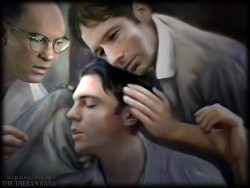When The X-Files debuted, nobody knew the small, weird show would be a success. But it had something better than a marketing blitz: It had the internet as a way to connect people who wanted to believe.
Fox recently announced that it was bringing back its iconic ’90s paranormal horror touchstone for a six-episode revival, a move spurred by renewed interest in the series thanks to Netflix streaming. A rising tide of ’90s nostalgia carries all reboots, I guess, but The X-Files is especially suited to a digitally influenced revival: The nine-season conspiracy classic is like a media relic fairy godmother to internet culture.
The X-Files plot lines were often suspicious of, even fixated on the perils of technology, but Chris Carter’s chronicle of belief, paranoia, and unresolved sexual tension actually ended up owing its success to technology. The show shaped how contemporary fandom works, bringing participatory media and nerd culture into the mainstream.
The Birth of Internet Fandom
The show premiered in 1993, or several thousand space aeons ago in Internet Time, before Tumblr was even a twinkle in David Karp’s eye. Mosaic web browser had just debuted earlier that year. So had the Windows version of AOL. Still, the first X-Files online fandom groups started growing on Usenet and IRC within months of debut.
Alt.tv.xfiles, which is still an active forum, sprang into one of the first flourishing fandom hubs. It was followed by a bloom of competing groups and thousands of garish Geocities websites, from the (impeccably named) David Duchovny Estrogen Brigade to the (also impeccably named) Order of the Blessed Saint Scully the Enigmatic.

It was one of those lucky moments of convergence where a show that questioned authority and promoted fringe or alternative thinking came out just as the greatest tool for subversion and spreading unconventional ideas became mainstream.
Fans adopted the new technology of the internet to talk about the show, helping the Friday night cult hit balloon into a pop culture phenomenon These fans pioneered a new way to interact with media that presaged social media.
I discovered The X-Files in re-runs as a gangly, easily embarrassed 13-year-old in the late ’90s. I found the online fandom soon after. The re-runs were aired out-of-order, and I learned to tell what season it was by the tailoring on Scully’s practical pant suits. Blockbuster only had the first season, so I started digging around, using my mum’s slow Compuserve to make sense of this dense, dank, claustrophobic show. I filled in the plot holes by reading websites.
Shippers
I discovered a full digital community along with the plot synopses I was after, with fierce infighting and strange niche factions but an overwhelming sense of camaraderie among people celebrating Scully’s furious rationality and Mulder’s moony surety and the potential that everyone’s favourite basement-dwelling special agents would someday woo (or just do) each other.
I was a “shipper”, as in, relationshipper — a category of fan yearning to see Special Agents Fox Mulder and Dana Scully fall wildly in love. The term “shipper” is now a standard word across modern day fandoms, but the term really first caught on among X-Philes. And “X-Philes” was the name fans gave themselves, a play on the Greek word for love.
As a self-conscious teenager, I didn’t tell any of my friends about my fixation with fan-written stories about the Agents Mulder and Scully. Even though I kept my hobby secret, I didn’t feel lonely. I had a community — it was just online.
And thriving: People logged on, waiting for the staticky gurgle of dialup to discuss theories about the show’s complex mythology. Who was Deep Throat, the first of Mulder’s many shadowy informants? How far did the conspiracy go?
The X-Files‘ paranoid epistemology meant that the internet and computers was as steeped in menace as any other sprawling, faceless system — watch Mulder and Scully face down evil computer-based artificial intelligence in “Ghost in the Machine” and the William Gibson-penned “Kill Switch”. But offscreen, the cast and crew were well aware of how the technological revolution had dramatically amplified its fanbase, and they didn’t take it for granted, frequently interacting with the online fandom.
Activity on message boards even ended up directly influencing the show’s course. “I remember one specific instance where I was actually inspired to write an episode based on something I read on a message board,” show producer Frank Spotnitz wrote Bambi Haggins, an academic who has written about X-Files fandom. “I read one comment noting that we hadn’t followed up on the death of Scully’s sister earlier in the year.” Spotnitz wrote the episode “Piper Maru” based on his lurking. Later on, The X-Files named a guest character after a prominent online fan named Leyla Harrison who had died.
Media theorist Marshall McLuhan famously described TV as a collective unconscious, a way to dream in groups, and with The X-Files, the internet provided a portal for a more lucid kind of dreaming, with fans actively helping shape the show, adding layers to the narrative through their analysis and fan fiction. And as the intensity of fan culture helped push The X-Files forward, it also pushed the online community at large forward.
The X-Philes
My friends would have looked at me like I’d just screamed that aliens were living in my butt if I’d have confided in my love of reading amateur romance blogs about fictional sexually frustrated federal employees to them at the time, but within the X-Phile community, shipping and fan fiction was mainstream.
A healthy contingent of the “X-Philes” were invested (or, well, painfully obsessed) in Mulder and Scully developing a romantic relationship, something dubbed “MSR” for “Mulder Scully Romance.”
And MSR wasn’t the only shipper coupling: You could read about a wide variety of potential romances, including “slash” couplings like Mulder and the mysterious (but hot) Agent Krycek or Mulder and his stern (but hot) boss, Agent Skinner. Mulder/Krycek was one of the first major “slash” couplings, and for nearly a decade fans held organised awards to recognise the sexiest Mulder/Krycek erotica.

Cheering on the (fictional) relationship of two people as a form of entertainment certainly did not begin or end with The X-Files. One X-Files fan told me that he saw the shipping tradition, especially as it applies to the largely chaste relationship between Mulder and Scully, as an extension of courtly love — a modern iteration of rooting for dutiful love among idols.
But it was in The X-Files community where it took its modern form, with groups clustering to feverishly imagine Mulder fingering Scully in the FBI Headquarters bathroom in 30,000-word novellas. And it was around X-Philes that fan fiction communities first blew up online, so if you’ve ever marvelled at the wonders of Clippy erotica or sexually explicit stories about NFL stars boning housewives, you can thank the chemistry between David Duchovny and Gillian Anderson.
The Fanfic Explosion

After The X-Files put fan fiction on the map, other groups took it and ran and ran and ran until every fictional pairing you can think of has probably been portrayed engaged in some seriously deviant acts.
Fan fiction is frequently disparaged, and I cannot lie: Much of it is bad. So, so bad. Fifty Shades of Grey started out as fan fiction about Twilight, and that can be forgiven but NEVER forgotten. But no matter its literary merits, fan fiction is an voluminous, fervent manifestation of participatory internet culture. Fans rewrite and reshape their favourite characters, fulfilling wishes and subverting canon and essentially rioting against the limits of the traditional reader-writer divide.
This shit isn’t new — people have been writing unauthorised, derivative fiction for hundreds of years — even the 18th century novel Pamela had fan-penned sequels. (Unrelated: Pamela is the most boring book I’ve ever read!) And Star Trek fans used to print out and circulate fiction based on the show.
The internet didn’t generate a compulsion to create fan art, but it made it so easy to share and find an audience for niche interests that anyone looking for self-published poetry about the Cigarette Smoking Man or romantic YouTube collages could sniff them out. The X-Files was the first show with fans to start sharing en masse.
Even though the show’s crew was largely interested in the online fandoms, 20th Century Fox took a far harder stance, especially towards fan sites sharing unauthorised images of Mulder and Scully. Fans organised, fighting for their right to post artwork and stories about their favourite characters. Without pushback, the studio could’ve stymied the fan fiction community — as well as remix culture, which is also sometimes attacked as derivative — before it had a chance to take off.
The X-Files has been off the air since 2002, but in the past few years it has enjoyed a resurgence in cultural relevance. (I’d prefer not to ever mention the existence of The X-Files: I Want to Believe, the bizarrely boring 2008 movie). Netflix and other streaming services have brought in a new audience for the show, providing a second wave of fandom that is likely to increase as anticipation for the reboot builds.
Plus, some diehard fans never left. Many of the original websites are defunct, but some are still rocking. Pockets of X-Philes have switched to modern platforms like Facebook, Reddit, and Tumblr as places to congregate, fans like comedian Kumail Nanjiani (my beloved Dinesh from Silicon Valley) are paying tribute to the show through more recent tech trends. Nanjiani’s The X-Files Files podcast is an example of how fans are continuing to play around with digital formats to pay tribute to their show.
During a separate podcast appearance this year, Gillian Anderson directly encouraged fans to tweet at Fox as a way to put pressure on the network to bring the show back, underlining how well she understood the way online fandom communities can influence media decisions over 20 years after she started playing a character pivotal to establishing those exact communities.
Pictures: Tara Jacoby, Geocities
